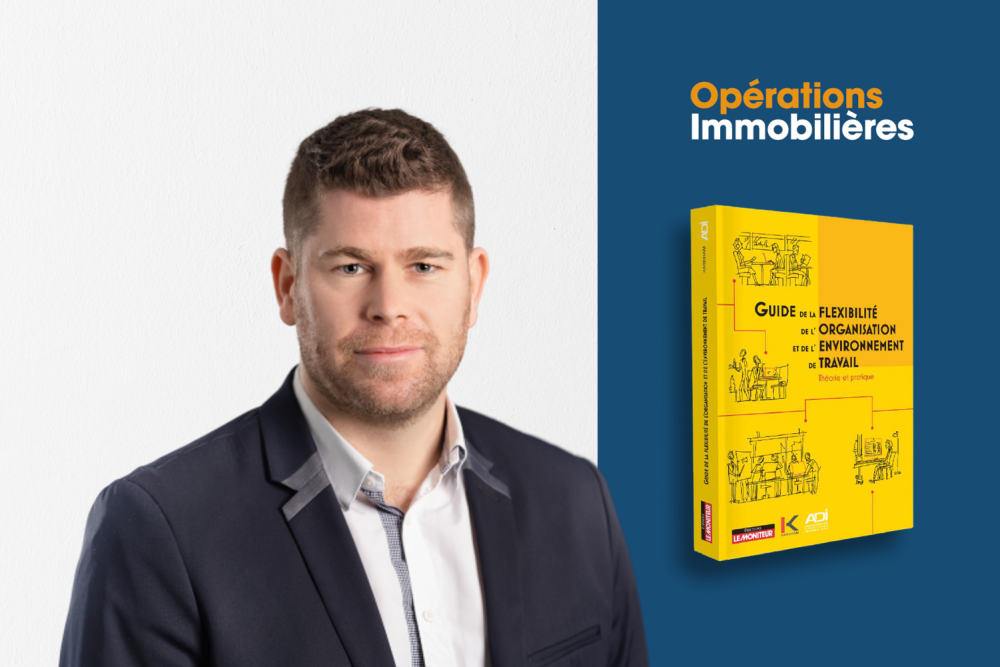- Home
- EN
- Kardham Group
- News
10 questions about flex-office with Nicolas Cochard, R&D Manager at Kardham
April 2021

The current health crisis is leading real estate managers to question the future of their office. Born almost 40 years ago, the flex-office is one of the solutions for optimizing the occupancy of premises by allowing each user to choose their workstation. Synonymous with loss of territory for some and a source of well-being for others, this notion is also seen as an accelerator of flexibility within the company. Let's take a look at the flex-office and the complex notion of flexibility.
Article published in the journal Opérations Immobilières in April 2021.
1. How to define the flexibility of space?
Despite a significant amount of research on flexibility, the lack of a clear definition favors the instrumentalisation that is made of it in the debate because flexibility is both the best and the worst prospects according to one or the other. The debate should therefore not be Manichean, “flex or not flex”, including for the flex office.
Spatial flexibility is not an end but rather a strategy that sets the conditions for achieving organizational performance. Spatial flexibility is understood then as a conceptual and material framework which provides a cultural framework.
Many definitions agree on the fact that the flexibility of organizations refers to the ability to vary organizational options, decision-making and operational scope, to limit constraint and to master short time frames. This flexibility must be part of a stable framework because flexibility is not disorder. Defining flexibility is therefore difficult because each organization finds its own paths to flexibility and this is partly why it is difficult to define it.
2. Is the flex-office a new arrangement?
No. In a way, the flexible desk appeared in the 1980s as a spatial translation of the post-Glorious Thirty-New deal, less focused on linearity. Gradually the non-territorial office, in which use is favored instead, appears. This is what IBM had already designed in 1970 in the United States through unassigned cellular offices with a variety of spaces dedicated to functions other than the individual production task. The beginnings of the flex office in the form of Activity Based Working are there.
The conceptualization of the flexible office is the work of two Harvard professors, Philip Stone and Robert Luchetti who, in 1985 in an article entitled "Your office is where you are", promote a reduced individual workstation for the benefit of others. spaces favoring travel and collective work. The company is seen as reticular and space must be a lever to activate this network.
If the optimization of surfaces and therefore that of the important item of expenditure that constitutes real estate is an undeniable entry point, the flexible office is also the result of a more uncertain economic environment but also of the evolution of working methods that can be qualified as “new” for executives in the tertiary sector.
3. Is setting up a flex-office just a surface optimization project?
Real estate is the second largest cost item for an organization after payroll.
The flex office is then one of the possible responses to control the costs of the work environment for two main reasons. It makes it possible to optimize the occupation of the workstation in a context of random employee presence. The flexibility of the workspace also leads to flexibility of the organization, which is better able to easily absorb its changes, staff growth or organizational reconfiguration in particular. However, a project to make working environments more flexible that is limited only to the economic dimension would undoubtedly be doomed to failure.
The economic dimension is a major input to a flex office project and it cannot be denied. However, it should be remembered that many projects do not necessarily reduce surfaces and the gain is mainly made at the level of the workstation which, once shared, is optimized. This is why the flex office is first defined by a ratio between the number of employees and the number of workstations, not forgetting that an individual working position is most often accompanied by other work positions in other areas of the company. The current flex office integrates well-being and satisfaction considerations, paths towards the creation of value in environments of this type.
4. What do we gain with the flex-office?
The flex-office allows you to gain the ability to choose the best place to perform a task throughout your career as a worker, this being valid both within and outside the walls of the company. If the flex office is really accompanied by flexibility in the user journey, there is an overall gain in quality of life, linked to better performance. The gains linked to the implementation of a flexible environment then ultimately come from a cultural dimension of the company with values linked to autonomy, trust and accountability. The gains linked to the flex office can therefore be observed at the individual level.
However, the most clearly identified gains are at the collective level with possibly internal social dynamics that stimulate the exchange, sharing and circulation of information. But let's be clear, space is only a lever since these dynamics relate to humans and spatial transformation is never more than a support.
5. Is flex-office better for collaboration?
Promoting the flex office often involves asserting its direct role in collaboration. The flex office seems to be a spatial adaptation to the need to collaborate, in other words to think of work differently from the individual production of each employee. However, the effectiveness of collaboration in the spaces that promote it is not yet proven.
Collaboration requires specific spaces, which flexibility can allow due to the optimization of areas dedicated to individual workstations. These collaboration spaces must also be located as close as possible to individual workstations in order to make them an easily accessible resource.
The principle of flexibility is always to make space a resource and never a constraint. The main advantage of the flexibility of the workspaces then lies in the control of the collaboration situation that allows the multitude of spaces offered.
The flexible space, accompanied by autonomy in the management of its mission, then allows workers to find the best collaboration situation. The great satisfaction observed among flex office users comes mainly from their ability to choose and control the times and conditions of collaboration.
6. What is lost with the flex-office?
The flex office is the subject of criticism mainly in connection with a feeling of loss on an individual level. The absence of a designated workstation disrupts, and this is normal, the territorial control of individuals in the workplace. These psychological aspects should not be underestimated because territoriality is part of the unchanging needs of the social animals that we are.
Also, the loss of the assigned office is not incompatible with the processes of re-territorialization, appropriation and attachment to space. Instead of a purely individual logic, it is collective logics which then develop.
Finally, if the loss of privacy, confidentiality and benchmarks are often mentioned with the flex office, a more flexible organizational culture will allow the user to make a positive balance between the losses and the gains that he will observe.
7. Why is employee participation a success factor?
Participation in the production of one's space responds to a primary need of people regarding spatial issues because being an actor in space production means making one's place, one's territory, one's place, which gives meaning to one's presence. And common sense indicates that the participation of users in space production is a major factor of satisfaction. The participation of staff in the design of the workplace improves the overall perception of the workplace but also comfort in its three dimensions: physical, functional and psychological. Caricature a bit, a flex office project without participation would be the worst possible scenario. The virtues of employee participation in the design of their work environment are numerous, if only because overall negativity decreases considerably by involving occupants.
Participation fosters a feeling of association and is a way of sharing the company's vision and its core values. It also improves the sense of identity of the future space and promotes ownership, attachment, territorialization, the feeling of control, sources of satisfaction. Especially since beyond the time of transformation, user participation can be part of a continuous managerial dynamic of empowerment. The participatory approach therefore presents virtues which are not limited to the spatial dimension and which stimulate or maintain positive social dynamics.
8. Is an employee reluctant or resistant to flex-office?
Resistance to change is a very natural behavior. When we touch on spatiality, we touch on the identity and social position of people. We resist because we fear losing our bearings and part of our individual and collective history.
Showing resistance to the introduction of a novelty is not necessarily an opposition to that novelty but more a fear of losing the bearings before. When it comes to flexible work environments, resistance is often great because the loss is significant, which requires even more support and teaching. Strategic thinking will transform resistance into support because it is an opportunity to move forward. Indeed, research indicates that resistance is positive because it highlights the importance of the work environment in the eyes of employees. You resist for something that is important to you and for which affects come into consideration. But resistances are lower when value is created collectively. However, participation must be sincere and grant real decision-making and guidance power for users. Insincere participation is therefore a source of resistance.
9. Why is flex-office becoming a taboo word?
More and more, the use of the word flex office is banned, at least strongly discouraged, by owners and boards alike, who see it as a source of difficulty in managing change. Most often, in order to avoid the forbidden word, we talk about dynamic, agile or activity based environments.
The flex office, whose term is clearly a variation of the “flexibility” paradigm, was originally intended, among other things, to convey positivity, an image of modernity and offices in tune with their time, the landscape of Californian start-ups that provided the standard meter.
However, preconceptions are often linked to fear ... and often that of the fear of losing something with certainty on an individual level. This certain loss is accompanied by hypothetical gains promoted throughout a project, especially at the collective level, without being easily observable a posteriori. Indeed, if the project teams, both on the owner's side and on the consulting side, are keen to promote the ameliorative effects of spatial flexibility, the results remain very uncertain and question the relevance of the promises associated with the flex office.
10. Does the flexibility of the working environment only come down to flex-office?
The workplace is no longer the only "place" in the work environment. It becomes multiple and is no longer exclusively attached to a centrality. Teleworking is obviously the main factor in this multispatiality, but not being uniform in its framework and in its practice, it gives rise to highly variable multispatial experiences.
Anytime anywhere work is growing strongly and the flex office is one of the responses to the lesser presence of employees on site. The fragmentation of the workspace reinforces the high-value centrality of the workplace. This is when the notion of the work environment takes on its full meaning because it becomes the whole of the material and human space in which the work is performed. If the work is done in different places and the employee gains flexibility by choosing the most suitable places for his task, then the environment as a whole becomes flexible.
However, if multispatiality offers more spatial possibilities to the worker, it must remain a choice and not a constraint because expectations in this area are very heterogeneous. The flex office is then only an on-site translation of a working environment that has become
flexible in a global organizational and cultural approach.
Show more
To go further, discover our Guide to Flexibility, Organization and the Work Environment.


